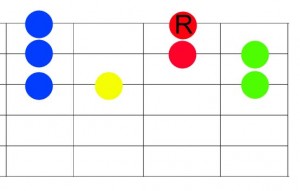Learning scales without Tabulature can be a quicker way to get to grips with the guitar.
It will involve patterns and of course learning the notes on the strings.
These patterns are useful because they are movable in the same way that a barre chord is movable.
If you’ve already looked at TABS of scales you may be aware of common patterns.
Below is a common scale pattern,
1 octave major scale pattern.
By playing the above pattern (starting note = red circle with ‘R‘) on the 5th fret you will be playing the ‘A Major’ scale
Below is the TAB(tabulature) version – they should be exactly the same.
If they’re not then you’ve misunderstood.
1 Octave A Major Scale.
The nice thing about patterns like the one above they make you think more and learn the notes rather than rely on tabs.
Let’s look at playing the scale,
The Red circle with the ‘R‘ is the root note – the red circles are fretted by the 2nd finger.
You should be starting this pattern with the 2nd finger on the 5th fret to achieve the ‘A Major’ scale
The Green circles are your 1st finger.
The Yellow circle is your 3rd finger.
The Blue circle is played by your 4th finger.
::: Expanding Further :::
By playing the pattern above starting at different frets gives us different major scales.
3rd fret = G Major Scale
5th fret = A Major Scale
7th fret = B Major Scale
8th fret = C Major Scale
10th fret = D Major Scale
:::Finally:::
It would be good practice to learn other patterns as well as these and I will cover those in future articles.
Also a good working knowledge of the guitar strings and their notes will be imperative to you taking this further.
:::Related Articles:::


